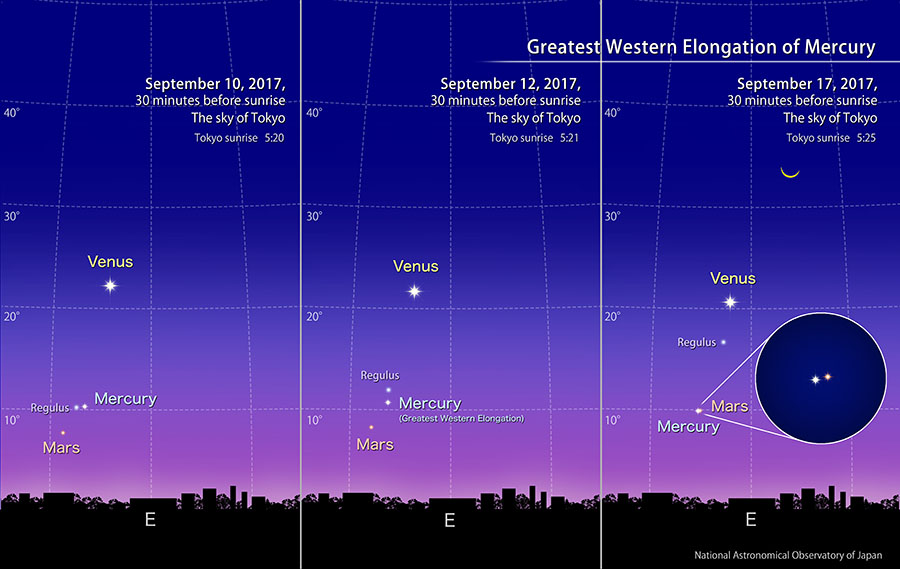Greatest Western Elongation of Mercury on September 12th (September, 2017)

Find Mercury at Dawn!
Mercury is at its best in the eastern sky at dawn.
Of the Solar System planets, Mercury has the innermost orbit. It is a difficult planet to observe from the Earth because it is always located in close proximity to the Sun. It is always located in the eastern sky just before sunrise when the sky starts to lighten, or in the lower western sky just after sunset while the sky is still bright. Therefore, even though Mercury is sometimes bright enough to reach negative magnitudes, it is very difficult to find because the sky’s brightness interferes.
Mercury reaches its greatest western elongation on September 12. Therefore, the altitude of Mercury is over roughly 10 degrees at 30 minutes before sunrise from the 10th to 16th. This makes it relatively easy to find. Also, Mercury becomes brighter so that its magnitude changes from 0 to negative, so conditions become better during the latter half of this period. How about trying to observe Mercury during this opportunity?
Once you find Mercury, search for the first magnitude star Regulus in the constellation of Leo just next to Mercury. The 1.4 magnitude Regulus is dim for a first magnitude star. But you might be able to confirm its existence with binoculars. On the 10th, Regulus and Mercury look closest to each other. As the days go by, they move apart. After the 12th, Mercury and Mars start to approach each other.
Mars is dimmer than Regulus; its magnitude is only 1.8. Therefore, it cannot be seen with the naked eye, and searching for Mars directly is very difficult. However, the apparent separation of Mercury and Mars becomes less than 0.1 degree on the morning of the 17th. This is very close so you can see them in the same field of view with a telescope. So, first find Mercury, peek at it with a telescope, and you can see Mars shining next to Mercury.
However, it is extremely dangerous if the rising Sun enters the field of view of the telescope. You can look up the times when the Sun rises for various locations in the Koyomi Station of the Ephemeris Computation Office, NAOJ.
Let's try to finish observation in good time! Do not try hard until the last minute before sunrise.
Reference: Ephemeris Computation Office
With the “Sky Viewer” you can easily explore the appearance of a typical urban night sky (planets and constellations are visible). The Celestial Phenomena section of the glossary explains the planetary phenomena terms: greatest elongation, opposition, conjunction, stationary, etc.